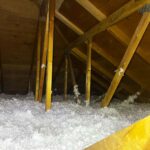If spray foam insulation is something you’ve heard of, but you’re not sure what it is exactly, you’re in the right place. Part one of this beginner’s guide will teach you the basics you need to know about spray foam insulation in Victoria so you can make an informed decision about whether or not it’s the right choice for your home.
WHAT IS SPRAY FOAM INSULATION?
Spray foam insulation is a style of insulation sprayed onto walls, ceilings, and other surfaces to make a barrier against heat and cold. It is made from two main ingredients: isocyanate and polyol resin. These two substances react when mixed together and sprayed onto a surface, expanding and hardening to form a solid barrier.
BENEFITS OF SPRAY FOAM INSULATION
Spray foam insulation offers many advantages over other options:
- It expands to fill any cracks or gaps in your walls, creating a tight seal that prevents heat and cold from escaping.
- It is an effective barrier against moisture, mold, and mildew.
- Spray foam insulation can help reduce your energy bills by keeping your home cooler in the summer and warmer in the winter.
TYPES OF SPRAY FOAM INSULATION
There are two common types of spray foam: closed-cell and open-cell. Let’s explore what each of these types of spray foam insulation has to offer.
CLOSED-CELL SPRAY FOAM INSULATION
Closed-cell spray foam insulation is the most popular type of spray foam insulation. It is made up of small, closed cells that are filled with gas. This gas helps the foam expand and harden, creating a solid barrier against heat and cold. Closed-cell spray foam insulation is more expensive than open-cell spray foam insulation, but it is also more effective at keeping out air and moisture.
OPEN-CELL SPRAY FOAM INSULATION
Open-cell spray foam insulation is less dense than closed-cell spray foam insulation. This makes it more flexible and easier to apply, but it is less effective at sealing out air and moisture.
Open-cell spray foam insulation is a good choice for areas that are difficult to reach, such as attics and crawl spaces. It’s also a smart choice for homeowners who want a more environmentally friendly option, as it’s made with fewer chemicals than closed-cell spray foam insulation. (At HD Horne Sprayfoam Insulation, we use the highest-quality, most environmentally-friendly options!)
Stay tuned for part two of this guide to spray foam insulation to learn even more!













